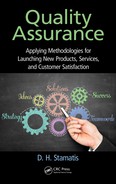Section II
Supplier Responsibilities
It has been said many times in many situations, “garbage in, garbage out.” In
fact, it is known as the GIGO principle. In the case of launching a program
on time, on budget, and with minimum interruptions (for whatever reason),
that process is a function of the supplier doing the “best” it can all the time.
Of course, in order for this to happen, the original equipment manufacturer
(OEM) (customer) must have identied the requirements.
There is no argument that the behavior of the supplier is of paramount
importance in this process. So let us identify the issues, concerns, and
requirements that any supplier has and the antidotes for poor performance.
To be sure, nothing is perfect! However, perfection can be dened based on
the set requirements that a customer requires of a supplier. Small or indifferent
deviations may indeed be overlooked, but in the case of the supplier satisfying
the customer, it is the supplier’s responsibility to either eliminate or minimize
the issues, concerns, or problems so that awless launching takes place. To
do this, an organization must have core business strategies, planning, and a
vision for continual improvement. This must be a way of life and a relentless
perseverance to perfection. A pictorial view of at least one approach to this
journey are shown in the core business strategy chart on the next page. There
are many variations of this, and every organization should develop its own.
In Section II, we are going to examine some of the requirements that every
supplier must understand and practice so that the customer will receive the
product and/or service awlessly. Above all, by following the concepts on
which we have focused, we are certain that organizations will improve dra-
matically. A survey in the Modern Machine Shop Journal (September 2014, 81–87)
supports my contention. The results are summarized in the table on the next
page. The article does not say what the overall sample was, but it does indi-
cate that the sample was taken from aerospace, automotive, military, and
equipment suppliers.

68 Supplier Responsibilities
One approach to core business strategy
VI. Level production
V. Pull system
IV. Synchronous production
III. Continuous flow
II. Stability
I. Vision
Ph
ase
Time
Management
labor relations
Share vision &
receive buy in
Develop roles &
responsibilities
TPM
Error
proofing
Empowered
teams
Flexible
work
Marketplace
Takt
time
Level
schedule
Every part
every day
Fixed
production
plan
JIT
Kanban
Improvement with
core business
strategy
Quick
changeover
Kaizen
Production
control board
Line layout
cell layout
Visual
factory
Baseline
analysis
Measurable
OEE, DTD, FTT
Smaller
lot size
Standardized
work
Value stream
mapping
Safety
programs
5S
Develop
vision
6-Sigma
Line load
analysis
Material
logistics
Improvement
without core
business strategy
Top Five Improvement Methods Top Five Supply Chain Practices
Items
Top Shops
(%)
Others
(%) Items
Top Shops
(%)
Others
(%)
Continuous
improvement program
85 55 Customer
satisfaction surveys
70 30
5S workplace
organization
63 42 Access to customer
forecasts
63 31
Cellular
manufacturing
44 25 Just-in-time
customer delivery
59 35
Just-in-time
manufacturing
44 30 Sharing forecasts
with suppliers
59 18
Quality certications 59 45 Design for
manufacturability
56 28
Furthermore, scientic evidence presented by Lakhal (2014) suggests that ISO
9000, total quality management (TQM) practices, and organizational perfor-
mance have a direct signicant relationship with excellence (p<.01). On the other
hand, Jones (2014) has identied the critical factors of success as being leadership
(p<.0001), measurement analysis, and knowledge management (p<.0001).
References
Jones, M. (2014). Identifying critical factors that predict quality management pro-
gram success: Data mining analysis of Baldrige award data. Quality Management
Journal 49–61.
Korn, D. (2014) What it takes to be a top shop. Modern Machine Shop September, 81–87.
Lakhal, L. (2014). The relationship between ISO 9000 certication, TQM practices and
organizational performance. Quality Management Journal 38–48.
..................Content has been hidden....................
You can't read the all page of ebook, please click here login for view all page.
